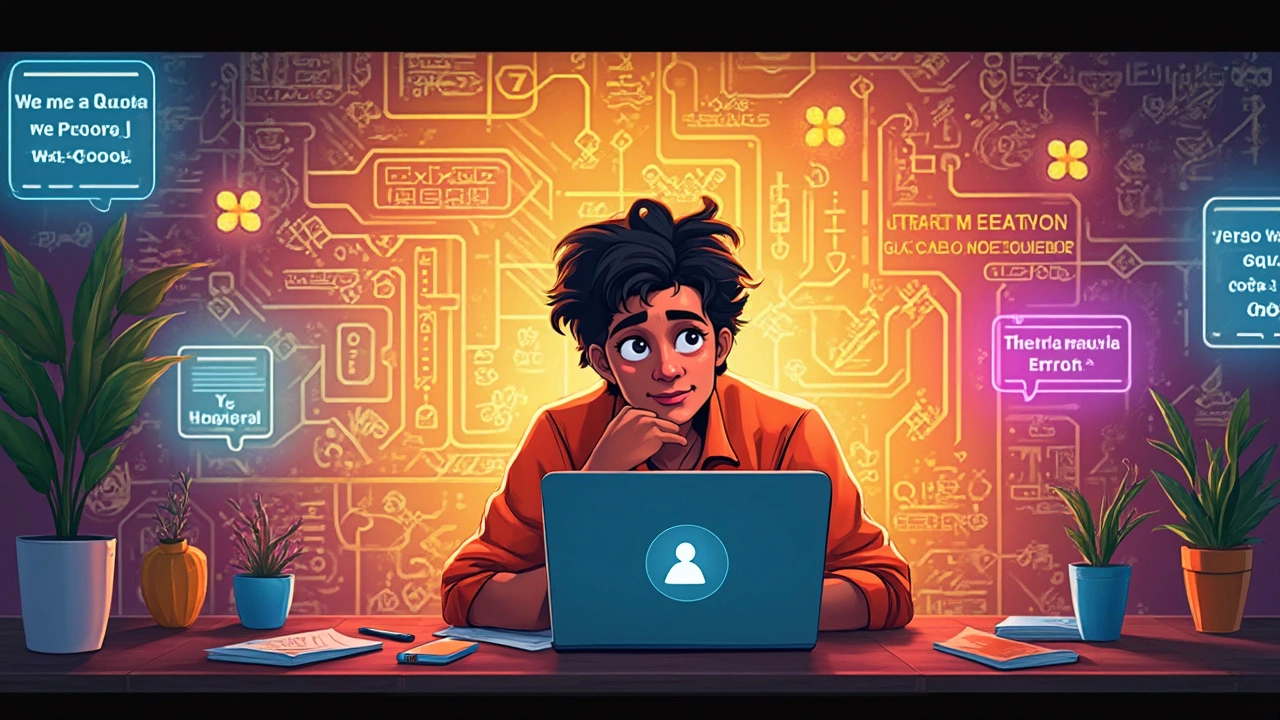Coding might seem like a magic trick, but for many, the hardest part is stepping onto this seemingly mystical stage. Yeah, the world of coding is like a maze of languages and logic, and getting lost now and then is part of the deal. What's a real kicker? It's the struggle to understand coding syntax. Ever tried learning French, but the only words you know are 'Bonjour' and 'Baguette'? That's what learning a new programming language can feel like, except the language doesn't buy you bread.
And let's not forget the thrill—or the terror—of debugging. The computer says, 'No!' and you're there scratching your head, trying to figure out what's gone wrong. Debugging is like being a detective, but instead of solving crimes, you're finding missing semicolons. Those error messages popping up? Think of them as your toughest critics—they point out the flaws, leaving no stone unturned. But hey, they’re also your best teachers in disguise.
- Decoding the Language of Code
- Facing the Debugging Dilemma
- Overcoming the Fear of Errors
- Mastering Time Management
- Finding the Right Resources
- Patience: The Secret Ingredient
Decoding the Language of Code
Learning to code is like diving into an ocean of strange symbols, where you're expected to communicate fluently in a completely foreign language. Sounds daunting, right? Yet, it's also what makes coding so intriguing. Every programming language, whether it's Python, JavaScript, or Ruby, has its own set of rules or syntax. Think of syntax as the grammar of the computer's language. Just like in English, where a misplaced comma can change a sentence's meaning, a single missing character can turn your code into a disaster.
The real kicker is that every coding language has strengths tailored to different problems. Python is like the Swiss army knife of coding, great for web development and data analysis. JavaScript is the go-to for making websites interactive. Knowing how to choose the right language for the job is half the battle won.
Now, it might sound robotic, but coding is all about logic. Embrace this logical thinking, and you'll start to see patterns. Writing code is about breaking down problems into bite-sized tasks and using the language's syntax to solve them. Remember, you're teaching your computer to perform tasks, step by step. Simple tasks build up into complex applications.
Here's a pro tip: practice is everything. Start with small projects. Create a simple webpage or a basic calculator. As you build, you'll realize that you're not just learning a language; you're learning how to think like a coder.
To help with that initial leap into coding syntax, check out some online coding platforms. Sites like Codecademy or freeCodeCamp offer interactive lessons that guide you through the basics, making the abstract art of coding feel tangible. They're like having a tutor right on your screen, explaining those confusing symbols.
So next time you see rows of code, don’t just see them as a mess of characters. See them as building blocks for something exciting. Every line of code is a line in a story just waiting to be told—and you’re the author.
Facing the Debugging Dilemma
Let's face it, coding can sometimes feel like a never-ending battle with the computer. You're typing away, certain you've cracked it, and boom—error messages start dancing on the screen. Debugging is where you truly get to know your code, whether you like it or not.
The first thing to understand is that debugging is all about problem-solving. Think of it as a detective game. Much like Sherlock Holmes, you dig through lines of code and clues to find out what's gone wrong. The good news? Most bugs fall into a few common categories. Misspelled variables, missing semicolons, improper function calls—once you've seen them, they stop being frightening.
One smart move is learning to read and understand those error messages. Yeah, they look like gibberish at first, but they often point right to the problem or, at least, its neighborhood. Stack Overflow can become your best friend here; it’s like a giant Q&A site for programmers who’ve been there, debugged that.
And let's not forget tools like debuggers—those things are magic. They let you pause the program, look at variables, and step through your code line by line. There’s a reason pros swear by them; they’re like having a superpower in the programming world.
Want a quick tip? Adopt a methodical approach. Break down the problem, look for patterns, and test in small bits. Comment out sections of your code to isolate the issue, or even write some test cases to catch those pesky bugs before they show up.
But hey, don't just take my word for it. Here’s a simple breakdown of why debugging is essential:
| Benefit | Description |
|---|---|
| Better Understanding | Debugging forces you to deeply understand your code and logic. |
| Problem-solving Skills | It hones your ability to think critically and solve complex problems. |
| Efficiency | Finding and fixing bugs early makes future coding smoother and faster. |
In short, facing the debugging dilemma is an inevitable part of becoming a better coder. Embrace it, learn from it, and you'll soon see it less as a nightmare and more as a valuable learning experience.
Overcoming the Fear of Errors
So, you're knee-deep in coding and it's throwing error messages at you like a game of dodgeball. It's easy to feel overwhelmed, right? But, trust me, errors are like the awkward dance moves of coding—they might look ugly, but they're all part of the fun. The trick is to not let the fear of errors hold you back.
First off, remember that errors don't mean failure. They are actually guiding you to improve your skills. Imagine they are like feedback from a wise old friend who just wants to see you succeed. Understanding this can change how you react when they pop up on your screen.
Here's a neat tip: treat coding errors as your to-do list. Break down the errors one by one and tackle them with a calm and systematic approach. Start by reading the error message carefully. Often, your first instinct is to panic and skim it, but take a breath and look at it patiently. Many error messages hold clues to help solve the issue.
- Google is your friend: If you're stumped, search the error on your favorite search engine. Chances are, someone else has dealt with it and posted a solution online.
- Comment and document: By keeping notes and comments on your code, you can potentially avoid repeats of the same mistakes or make debugging easier.
- Debugging tools: Use the debugging tools provided by your coding environment. Step through your code to understand where it's tripping up.
On a side note, many seasoned developers have shared that they spend about half their coding time debugging. So if you're spending hours rooting out bugs, you're not alone. Expecting and embracing the debugging phase as part of the process is crucial in learning and mastering programming.

Mastering Time Management
Jumping into coding isn't just about knowing your programming languages; it's also about juggling your time like a pro. Coding needs a lot of focus, and let's be real—hours can slip by without you even noticing. So, what's the trick to staying on top of things? It's all about finding a rhythm that works for you and sticking to it.
First up, set clear goals. Knowing what you need to get done keeps your eyes on the prize. Break tasks into bite-sized chunks, like dealing with one coding challenge at a time, instead of swallowing the whole book. This is where the Pomodoro Technique can be a lifesaver. Work for 25 minutes straight, then take a 5-minute breather. Rinse and repeat. It helps keep that brain burnout at bay.
Avoid the common trap of multitasking—it's not as efficient as you might think. Focus on one task, like debugging that stubborn error, before switching gears. Trust me, hopping back and forth only messes with your flow and wastes time.
Remember, coding is a craft that needs practice, like learning to play a guitar solo. But every minute counts. Check out this simple table to see how different tasks can eat up your coding hours:
| Task | Time in Minutes |
|---|---|
| Reading Documentation | 30 |
| Debugging Errors | 45 |
| Writing Code | 60 |
| Testing Code | 20 |
Finding the right balance between coding practice and other life stuff is key. Fit it all into a schedule that makes room for breaks, like grabbing a coffee or catching up on your favorite show. You'll soon crack the coding nut while still enjoying life's other gigs.
Finding the Right Resources
You know what's half the battle when you're trying to get a grip on coding? It's finding the right tools and resources that don't just leave you more confused. The coding universe is full of websites, books, online courses, and forums, but not all of them will give you the helpful nudge forward you're looking for.
If you're starting out, sites like Codecademy and freeCodeCamp are absolute lifesavers. They're structured, easy to follow, and cover everything from the basics to more advanced stuff. Once you're past the free stuff, checking out premium courses on platforms like Udemy or Coursera can really level up your skills. These places often have reviews from other learners, so you can make sure you're getting value for your money.
Books are great if you're the traditional type, with classics like 'Clean Code' by Robert C. Martin and 'JavaScript: The Good Parts' by Douglas Crockford being must-reads. Reading might take more time, but it often helps to see a problem broken down without the distraction of videos and notifications.
Don't overlook the power of forums like Stack Overflow for when you're stuck. It’s a gem for spotting patterns in the common coding challenges. And seriously, don’t shy away from asking questions. There's a massive community out there ready to help you troubleshoot.
Another cool way to learn is through developer communities on GitHub. You can contribute to projects or just nose around to see how others are doing things. Seeing real-world applications can make those abstract concepts finally click.
Ultimately, it's a mash-up of trial and error. Coding tips come best when you mix these resources to suit your learning style and needs. The trick is to find materials that keep you excited and hungry to learn more.
Patience: The Secret Ingredient
Ever heard that saying, "Patience is a virtue"? Well, when it comes to coding, it's more like a necessity. Imagine putting together a massive jigsaw puzzle where the pieces keep changing shape—welcome to coding. Without a doubt, patience is what separates those who thrive in programming from those who throw in the towel too soon.
Why is patience so crucial? First off, coding isn't just about writing the perfect line of code right off the bat—it's about debugging, experimenting, and sometimes just plain old trial and error. You’re going to hit roadblocks, but getting frustrated won’t help you find the solution any faster. In fact, patience enables you to take a step back, analyze the problem, and come up with a creative solution.
It's not just about sitting there and waiting for inspiration to strike, though. Good developers know how to channel that patience into structured learning and consistent practice. The catch? Unlike other skills, coding relies heavily on understanding complex concepts, which means endless hours of practice and the need for a research-loving mindset.
| Year | Hours Spent Learning |
|---|---|
| 2021 | 250 |
| 2022 | 300 |
| 2023 | 350 |
Don’t let the numbers scare you, though. This dedication pays off, allowing you to slowly but surely build a toolkit of coding skills. For those tackling the challenge head-on, it’s like slowly climbing a mountain. One step at a time, you’ll get to the summit.
So, how can you boost your patience? Start small. Take breaks when you're stuck; walk away and come back with fresh eyes. Create a routine where patience isn’t just an end goal, but part of the journey. Patience isn't called an ingredient for nothing—think of it as the key spice in your developer's pantry.



